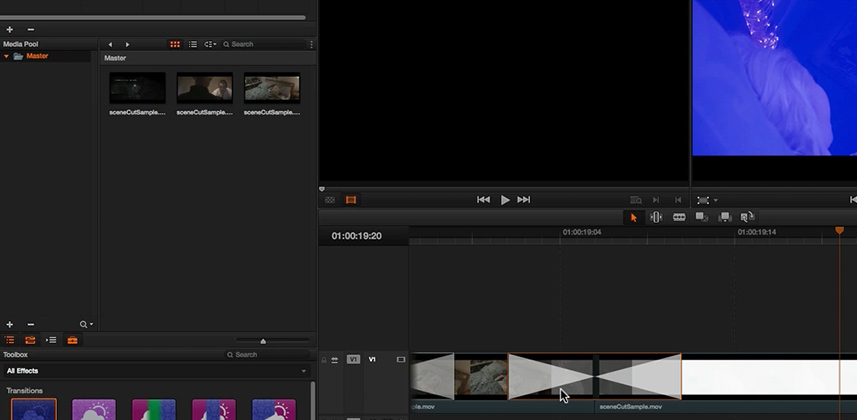Color Correcting A Film Trailer: Simple Compositing (in DaVinci Resolve)
Can you perform simple compositing in DaVinci Resolve? Yes. Plus, you can use blending modes and alpha channels to add visual effects or graphics.
Digging Deep With SpeedGrade's Color Wheels: Localized Contrast
The SpeedGrade color wheels seem basic. This is a deep look at its unique color correction toolset to see its real power, using RED footage.
Basic Visual Effects & Online Editing in DaVinci Resolve 10
Learn how to perform basic online editing tasks in DaVinci Resolve 10. This tutorial looks at compositing, titles and Sapphire plug-ins.
How To Use the RGB Mixer To Remove The Arri Alexa Film Matrix
Are you fighting a green color cast with Arri Alexa footage? This may be due to the Arri Alexa Film Matrix. Learn how to use Resolve's RGB mixer to fix it.
How I Set Up Scopebox for Color Correction
In this video learn how a professional colorist configures the affordable software scopes, ScopeBox, for image evaluation to speed up color correcting.
Color Correcting A Film Trailer: Sony FS700 Footage
In this color correction tutorial, we explore color correcting FS700 footage in our Fake Film Trailer. We'll also use Sapphire plug-ins for DaVinci Resolve.
How To Use The Premiere Pro Title Tool To Color Correct with Shapes
Using shapes to isolate areas of your image for color correction is a key color correction skill. Learn how to do this using the Premiere Pro Title Tool!
Color Correcting A Fake Film Trailer: Grading RED Dragon Footage
In this installment of the Fake Film Trailer, I start color correcting Red Dragon footage. It's my first time working with this camera.
Color Correction Time Management: Grading in Passes
It's easy to get lost in the weeds when color correcting. Learn a Color Correction Time Management technique that keeps you from missing deadlines!
Video Noise Reduction In DaVinci Resolve: The Neat Video OFX Plug-in
We explored video noise reduction in DaVinci Resolve 10 earlier. In this tutorial you look at the OpenFX plug-in, Neat Video, and compare the differences.
Video Noise Reduction In DaVinci Resolve: The Built-In Toolset
Explore DaVinci Resolve 10's built-in video noise reduction tools. It's available to paid owners Resolve 10. Should you upgrade? Watch Parts 1 & 2...
How To Create a Dream Sequence Look: 'Heavenly Whites'
The Dream Sequence Look is commonly requested. You learn how to create a 'Heavenly White' Look for an indie feature film—and try it out on your next job. No plug-ins, just the standard tools you'll find in most software.
Adding Tension by Animating Power Windows: The Spaceship Sequence
We're going to use DaVinci Resolve key frames with animating Power Windows—dialing up the tension and creating the feeling of alien ships flying over head.
Is Working For Free A No No? (Or Can It Be Good For You?)
Is working for free a huge professional mistake? Not necessarily. Learn how to handle these requests like the video professional you are.
Scene Cut Detect (& Preconformed Workflows): Dealing with dissolves
When using Scene Cut Detect (or Preconforming) in DaVinci Resolve, how do you deal with Dissolves? Watch the video and learn the very simple answer.
How to Prepare A Film Trailer For Color Correction
Learn how a professional colorist evaluates a project (film trailer) before a single shot is color corrected - a critical step for smooth sessions.
FilmConvert Review: In Action to Color Correct RED Footage
In part 2 of our FilmConvert Review you'll learn how to use this OpenFX plug-in on RED footage, with impressively good results.
An Introduction to the OpenFX Film Convert Plug-In: Part 1
Part 1 of our two-part overview of the Film Convert Plug In. Learn how to use the OpenFX version in DaVinci Resolve 10 and explore its various options.
Going Freelance As A Colorist + Using Scopes With RAW Footage
When is the right time for going freelance as a Colorist? Do scopes work with RAW? We answer Member questions in Episode 6 of our Podcast.
How to Color Correct Using LUTs (By Preparing Your Images)
If you're confused on how to color correct using LUTs, this video (one in a series) shows several different approaches for you to try.
How to Emulate the Clarity Slider + Color Correcting in VFX Workflows
Three professional colorists discuss how to emulate LightRoom's Clarity Slider in DaVinci Resolve. Plus, where color correction fits in VFX workflows.




















